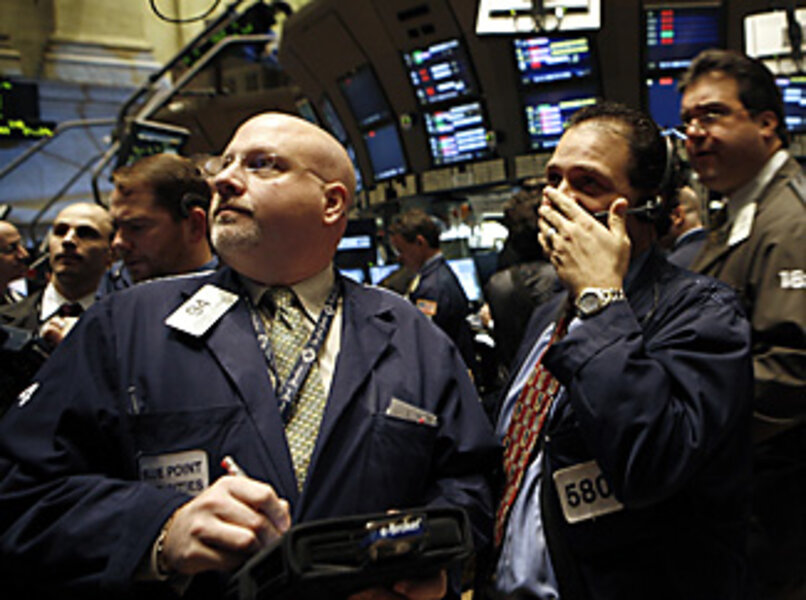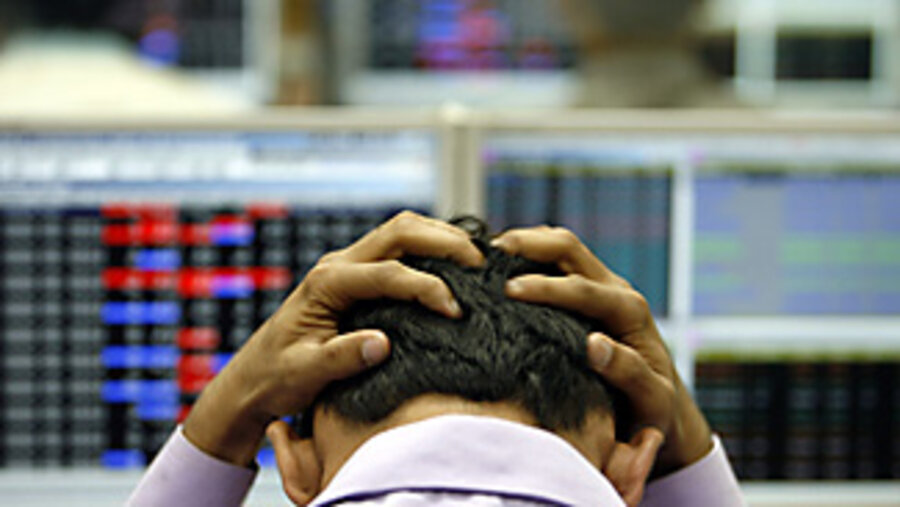Fed races to ease market fears
Loading...
| New York
The Federal Reserve is racing to get ahead of the deteriorating economy and jittery markets.
The nation's central banker dropped short-term interest rates on Tuesday morning by three-quarters of a percentage point, a move not seen in at least 20 years. In a statement, the Fed indicated it would consider dropping rates some more in the future if the financial markets continue to plunge.
The Fed's action comes against a backdrop of roiling world markets. Japan's Nikkei stock average closed down 5.65 percent Tuesday – its biggest drop in percentage terms in almost a decade. In Hong Kong, the Hang Seng index fell 8.65 percent a day after enduring its biggest decline since the 9/11 attacks. European markets recovered from losses after the Dow Jones Industrial Average rebounded in morning trading from an initial decline of more than 400 points.
"The Fed had to react, they had to show they were prepared to show leadership when needed," says Lyle Gramley, a former Fed governor and a consulting economist at the Stanford Washington Research Group. "There would be no hope if they were seen as confused and unwilling to respond."
Some economists believe the Fed felt it had to act ahead of its normal meeting next week because the turmoil in the stock markets risked spreading into the credit markets where companies go to fund their day-to-day operations.
"After the markets closed in Europe on Monday, the Fed had a meeting and must have seen a real drying up of liquidity," says John Silvia, chief economist at Wachovia Securities Corp. in Charlotte, N.C. "They realized they needed to supply more liquidity so people can meet their obligations and payments."
Some market participants were relieved by the Fed's actions. "It shows they understand the severity of the situation," says Bill Stone, chief investment strategist for PNC Wealth Management in Philadelphia. "Now, hopefully, the market believes the Fed gets it."
The financial markets are also concerned about the financial health of some of the companies that insure municipal bonds and other debt instruments. "If there are questions about the ability of these companies to insure bonds, business and state and local governments will be unable to issue debt and finance their operations," says Mr. Silvia.
At the same time the Fed is fighting to prevent the economy from sliding into a recession. Many economists believe the economy is already in negative territory.
"So much involves psychology," says Scott Brown, chief economist at Raymond James & Associates in St. Petersburg, Fla. "If enough people believe we are in a recession, it could be self-fulfilling."
The sharp drop-off in the stock market is not helping the Fed either. Some of the US stock averages have now dropped close to 20 percent, widely considered to be a sign of a bear market, and all three major markets are now on pace to have their worst January in history, analysts say. As stocks drop, it adversely affects corporate confidence, says Fred Dickson, chief market strategist at D.A. Davidson in Lake Oswego, Mont. "The volatility causes business leaders to pull back on their spending," says Mr. Dickson. "So if we're not in a recession already, the market has made it one."
However, some economists are not certain the Fed should be reacting to the markets. "The action itself creates its own concern," says Mark Zupan, dean of the Simon School of Business at the University of Rochester in New York. "You worry that people will ask, 'How bad can it really be?' "
The Fed's actions follow the Bush administration's proposal last week to stimulate the economy by tax rebates or incentives by $145 billion. Congress says it will pass a stimulus bill quickly. And economists believe it could add nearly 1 percentage point to the economy's growth once the checks start arriving in mailboxes.
However, Dickson says the size of the plan may have surprised skittish investors in Europe and Asia. "The Bush plan was twice as large as some of the proposals before Congress," he says. "It sent a big signal that the US is looking at something quite severe."
Mark Rice-Oxley reports from London:
European markets endured another day of turmoil despite the Fed's intervention. News of the rare 3/4-point cut gave many investors some respite after another wretched start to the day. By the end of the day, the benchmark indices in London (FTSE 100), Paris (CAC 40) and Frankfurt (DAX) all ended firmly higher.
The fear in Europe is twofold: that economies this side of the Atlantic will suffer if the US does descend into recession, with markets for European goods and services taking a hit from the recoiling US consumer; and that central bankers in Europe might not act as speedily as their American counterparts in addressing the situation.
"The jury is still out on whether this [Fed rate cut] will work," says Julian Jessop, an economist with the London-based consultancy Capital Economics. "Equities have regained some ground on European markets, but they are still substantially lower than they were at the end of last week.
"Europe is exposed [to the US] but there is also a fear that policymakers in Europe will be slow to respond," he adds. "Even though the problems are triggered by a crisis in the US housing market, there is a perception that Europe is just as vulnerable."
The Bank of England said it had no plans for an emergency interest-rate decision before its next scheduled meeting Feb. 6. Many analysts now think that meeting will produce a rate cut. The FTSE 100 index has now suffered its worst start to a year since records began, 14 percent lower than it stood on Jan. 1. The European Central Bank has avoided rate cuts through the current credit crunch crisis.






